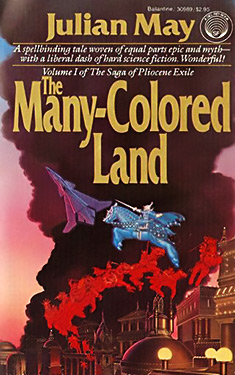Julian May
Completed 6/16/2020,
Reviewed 6/16/2020
4 stars
This was a surprisingly
good book with one-way time travel, psychic abilities, aliens, and a dash of
fantasy. It uses the common trope of a
motley crew of humans who try to overthrow the alien overlords. I found it started slowly, introducing the
large cast of characters, then built up to a better pace as the plot settled. The cast is very diverse, including different
nationalities, a nun, and an unstable lesbian.
This book was written in the early 80’s, so most of the
characterizations are a bit stereotypical, but not too bad. There were a few deep cringes, such as the
use of the slang term for the Romani people.
But I felt that the author tried really hard to be inclusive and if she
were writing today, she would have done a better job of it. The book was nominated for a slew of awards
and won the Locus Award for Science Fiction.
In the
twenty-second century, humans have settled around the galaxy. One man on Earth discovered a time machine
which successfully transports back six million years to the Pliocene Era, but
destroys any living thing trying to come return. It becomes popular with the misfits of the
galaxy as a form of self-imposed exile, looking to start fresh somewhere else,
outside the mores imposed by the galactic social structure called the Milieu. The book begins with (I think it was) eight
people, giving their backgrounds and motivation for going back in time. When they finally do, they find that the
Earth has been settled by an alien race that has basically enslaved all the time
travelers over the years. Most of the
women are kept as sexual slaves because something about the sun has rendered
the female aliens barren, and the aliens are genetically so close to us that
sex produces viable offspring. The
aliens use a torc, a sturdy necklace of sorts, to control the humans so that many
of them don’t have qualms with life under the alien rule. But this rag-tag group will have none of that
and try to find a way to fight back.
The character
development isn’t bad. Since we get the
motivation of the travelers at the beginning of the book, we get a good sense
of who they are. A couple of the characters
actually grow in the course of the book.
My favorites were the nun, Amerie, and the lesbian, Felice. Amerie is burned out from her work as a caregiver
for the dying. She wants to follow her
original dream of being a hermit. She
was never accepted into any of the cloistered orders so she feels her one
chance to follow that dream is to take the Exile. Because of her medical background, she
becomes the medic for the exiled.
Felice is an
anti-social, hot-headed, former hockey star.
She wants to go because having been fired from the hockey team for violence,
she thinks it would be best to live life alone and self-sustaining. Once in the past, she takes none of the guff
of the aliens and is the first to try to plot against them. Her mission becomes to free all of
humanity. In an interesting development,
Amerie becomes one of the few people who can really get through to Felice to
temper her violent tendencies.
I found the
plot to be both inventive and juvenile. It’s
as if the author kept on throwing things into the mix to come up with something
new, but ended up creating something that appeals to the high school sci fi
nerd in the reader. But on the other
hand, that’s what I liked about it.
There isn’t much humor in the story, there is a fair amount of violence,
and like many stories with a large number of characters, it can be a tad
melodramatic. But it appealed to the
less mature, nerdy side of my tastes.
I give the
book four stars out of five because I thought it was very entertaining. The writing is pretty decent, with good
prose. There’s some exposition, but it
was reasonable. I give it props for having
a major lesbian character written by a straight woman forty years ago that’s not
man-hating nor falls into a butch/fem role, but she’s definitely
aggressive. What I liked best was that she
makes positive contributions to the group despite her temper. There are three more books in the
series. I don’t know if I’ll get to them
or not, but this book ends with only minor resolution, though it’s not a cliffhanger. You just have to read the next book to find
out what happens to half the characters.
I guess that sounds like a cliffhanger, but really, I felt this book
ended at a good spot. And it doesn’t
manipulate you to get you to read the next book. It’s simply that the story continues in the
next book.

No comments:
Post a Comment